The Outdoor Grower’s Almanac
An illuminating guide on the outdoor growing season — from start to finish. Discover everything you need to know about the outdoor weed season to ensure a stress-free experience.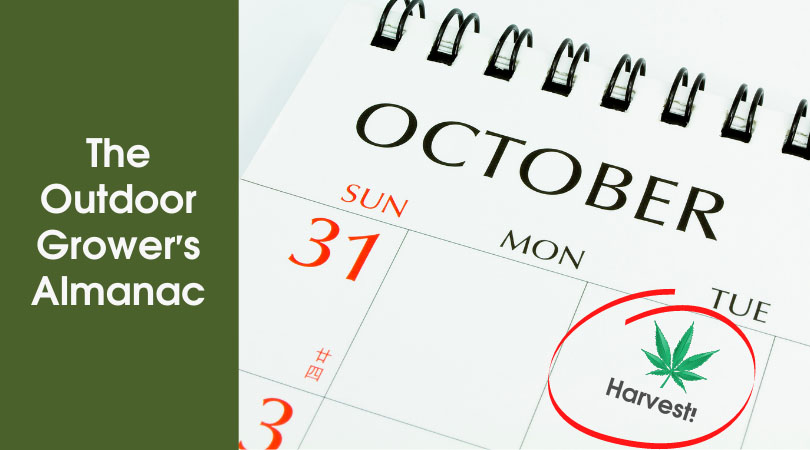 As a cannabis grower, the fun begins at the onset of the outdoor growing season.
As a cannabis grower, the fun begins at the onset of the outdoor growing season.
However, when does the cannabis growing season start? Furthermore, when does the outdoor marijuana growing season end? Dig into our Outdoor Grower’s Almanac to find the answers you’re looking for.
You’ll discover everything you need to know about the outdoor weed growing season, such as when to plant weed outdoors and when to harvest buds. With the help of this marijuana growing calendar, you can plan your outdoor grow accordingly.
Whether you’re a beginner or a green thumb, use this guide to maximize your outdoor marijuana yield and make this growing season worth it.
Let’s go!
The Outdoor Cannabis Growing Season According to Feminized and Autoflowering Seeds
The outdoor growing season will differ depending on your choice of feminized or autoflowering seeds.
Here’s a list of feminized characteristics that you must be aware of:
- Photoperiodic
- Require the length of the growing season to complete a full cycle
- Produce hefty yields
Next, here’s a list of autoflowering characteristics that you must know:
- Non-photoperiodic (do not require a specific amount of light hours to flower)
- Contain an internal clock to begin the flowering process
- Allows growers to complete multiple harvests within a single growing season
- Grows and flowers quickly
- Produces less bud compared to feminized seeds
As you can see, both types of cannabis seeds have advantages and disadvantages. However, the growing calendar is different depending on which you choose.
Let’s take a brief look at the growing season for both feminized seeds and autoflowering seeds.
The Outdoor Growing Season of Feminized Seeds
In its entirety, the growing season of feminized seeds lasts between April to November in the Northern Hemisphere and September to May in the Southern Hemisphere.
Depending on your region, you may experience a longer or shorter growing season as the weather shifts from spring, summer, and, eventually, fall.
As a special note, we’ve added the growing season months for the Southern Hemisphere. If you’re growing marijuana in Oceania, Southern Africa, or South America, the growing season starts and ends at drastically different times than regions in the Northern Hemisphere.
Let’s take a look at how the growing calendar starts and ends for feminized marijuana seeds.
Phase One — April (September in The Southern Hemisphere)
The outdoor growing season for feminized seeds typically starts in early April (September for the Southern Hemisphere).
Although your region may experience frost this early in the season, you can germinate the feminized seeds indoors. By doing so, you will have a jump start on the outdoor growing season.
If you haven’t yet, read our guide on how to germinate cannabis seeds.
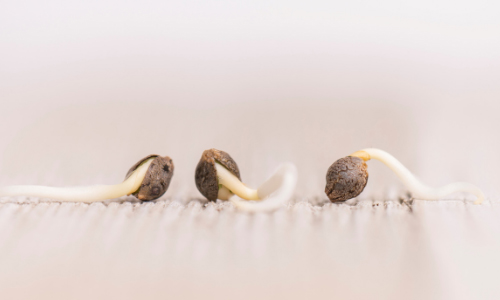
You can germinate weed seeds by using paper towels, rooting cubes, or soil.
Phase Two — May (October in The Southern Hemisphere)
Once the threat of frost has passed at the beginning of May (or October in the Southern Hemisphere), it’s time to plant your feminized strains by transplanting the cannabis seedlings in the ground or containers.
By this point, spring is in full swing, and each day brings longer daylight hours. As daylight increases, so does the growth among your marijuana crop.
By this point, you should:
- Check marijuana seedlings and juveniles daily
- Provide additional nutrient content
- Prevent over-watering by closely monitoring water uptake
- Protect from the elements (rain or wind)
Phase Three — June (November in The Southern Hemisphere)
By June (or November in the Southern Hemisphere), the days are long, and your feminized strains will produce explosive vegetative growth.
At this point, you should prepare support structures and trellis netting in anticipation of the flowering stage.
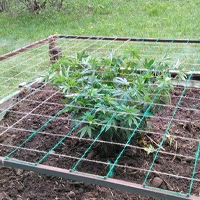
Additionally, this is the perfect stage to incorporate cultivation techniques to increase yield, such as:
- ScrOG
- LST
- FIM
- Super cropping
- Topping
Although each of the techniques mentioned above are stressors for the cannabis plant, they will bounce back quickly and resume normal growth.
Furthermore, you should:
- Feed your marijuana plants additional nutrient content via amendments or concentrated bottled nutrients (vegetative-specific)
- Prune lower growth to increase airflow
- Monitor for insect or disease outbreaks regularly
Phase Four — July (December in The Southern Hemisphere)
July (December in the Southern Hemisphere) is the final month of vegetation.
At this point, you’ll be shocked by the massive growth of your cannabis plants. By this point, you will notice your cannabis plants require a lot of water, nutrients, and sunlight to fuel their epic growth.
As long as you’ve followed our guide on How to Grow Marijuana Outdoors, your outdoor weed garden should explode with greenery.
Phase Five — August (January in The Southern Hemisphere)
Once August ( January in the Southern Hemisphere) appears, you’ll notice a change in your cannabis plants.
The nodes suddenly, as if out-of-the-blue, produce bud sites. The sudden burst of white pistils marks the beginning of the flowering stage, or better yet, the pre-flowering stage.
At this point, your marijuana crop will undergo what’s known as pre-flower stretch. In some cases, cannabis plants may stretch 2-3x their current size over the next two weeks.
Furthermore, the per-flowering stage is an excellent time to:
- Lollipop the underside of marijuana plants
- Ensure supports are ready to take on increased flower weight
- Inspect for disease or pest outbreaks
- Change the feeding schedule to a flower-friendly mixture
- Incorporate bloom boosters into the feeding schedule
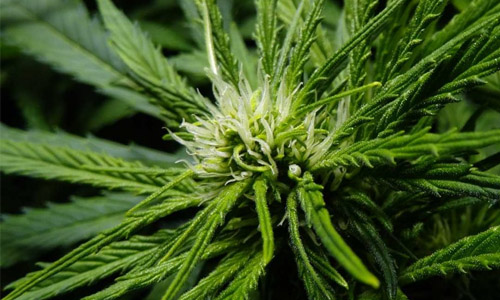
When you begin to see pre-flowers, your plants are entering the flowering stage.
Phase Six — September (February in The Southern Hemisphere)
Once September (or February in the Southern Hemisphere) begins, you’ll experience a steady stream of excitement as each day brings more weight to the flowers.
If you’re located in a region where cold weather prevails at the onset of fall — it’s best to choose fast flowering weed strains that finish by the 7-week mark. Any longer and you may lose your beloved crop to rain, frost, or snow.
Depending on the strain, harvest time may be extremely near. Remember, your cannabis seeds will have an estimated flowering window. Therefore, a 7-week strain will finish by the end of September.
Once you verify with a loupe that the trichomes are ready, it’s time to pull out the clippers and harvest!
If your cannabis plants are not ready to harvest by September, you must:
- Keep a close eye on the buds for bud rot
- Add natural bloom boosters to the feeding regimen, such as bat guano
- Ensure the support poles are propping up the buds
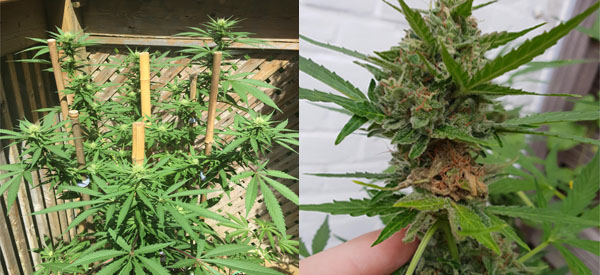
Left: Make sure to support the weight of your buds with bamboo sticks or a trellis. Right: Check closely for bud rot or pests.
Phase Seven — October (March in The Southern Hemisphere)
If your strain finishes flowering in 8-10-weeks, October (or March in the Southern Hemisphere) is your harvest month.
By this point, the flowers will be large and drenched with resin. Once you verify that the trichomes are ripe with a magnifying glass — it’s time to cut the plants down and begin the harvesting process.
Most outdoor cannabis growers that live in cold regions have already harvested by this point. However, if you live in a Mediterranean climate, the outdoor growing season usually ends by late October.
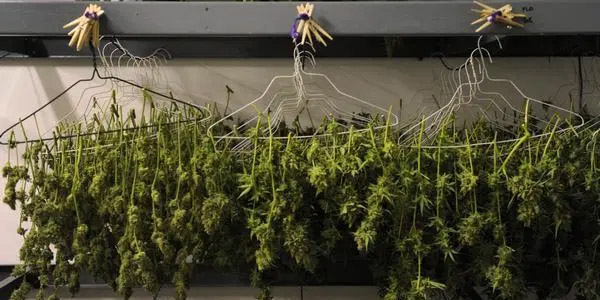
During October (or “Croptober”) is when most outdoor plants will finish.
Phase Eight — November (April in The Southern Hemisphere)
November is the deadline for the outdoor marijuana growing season. If your plants aren’t done — you need to make immediate plans to begin harvesting.
Nearly every region experiences frigid temperatures in November, which makes it impossible to grow weed. However, Mediterranean climates march on and allow cannabis cultivators to push their crops to the limit.
However, you must be on guard until harvest day to prevent damage from wind, rain, frost, and the increased likelihood of mold.
The Outdoor Growing Season of Autoflowering Seeds
One of the most popular methods to grow cannabis outdoors is with the help of autoflowering seeds.
Unlike feminized seeds, autoflowering strains do not rely on day length. Instead, auto strains utilize an internal clock that forces the plant to flower quickly. Therefore, you can produce multiple harvests in your garden in a single growing season.
Let’s take a look at how you can produce multiple harvests with autoflowering seeds.
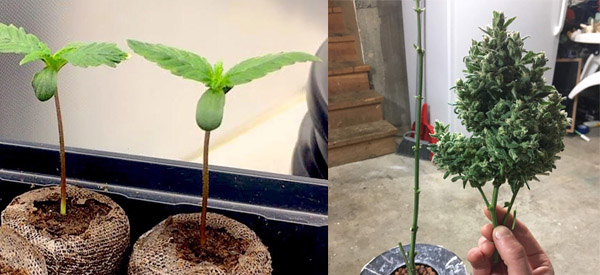
Autoflowers grow and flower quickly, allowing you to have multiple harvests throughout the year.
First Autoflowering Season From May – June (October – November in The Southern Hemisphere)
- Germinate a fast-flowering auto strain, such as Auto GDP, at the beginning of May
- Care for the plant by following our guide on How to Grow Marijuana Plants Outdoors
- Harvest by the end of June
Second Autoflowering Season From July – August (December – January in The Southern Hemisphere)
- Germinate a fast-flowering auto strain, such as Auto Widow, at the beginning of July
- Care for the plant by following our guide on How to Grow Marijuana Plants Outdoors
- Harvest by the end of August
Third Autoflowering Season From September – October (February – March in The Southern Hemisphere)
- Germinate a fast-flowering auto strain, such as Auto Bruce Banner, at the beginning of September
- Care for the plant by following our guide on How to Grow Marijuana Plants Outdoors
- Harvest by the end of October
Which Cannabis Seed Fits Your Growing Season?
Now that you understand how long the cannabis growing season is — which seed type fits your schedule?
As you can see, feminized marijuana seeds are perfect for those that want to experience massive yields, gigantic plants, and sky-high cannabinoid levels.
On the other hand, autoflowering genetics empower you with multiple harvests and a hands-free approach.
Regardless of your choice, you’ll be satisfied every morning as you look over your outdoor marijuana garden. Once you have your first outdoor growing season under your belt, it’s time to look ahead — and start planning next year’s outdoor cannabis cycle!
